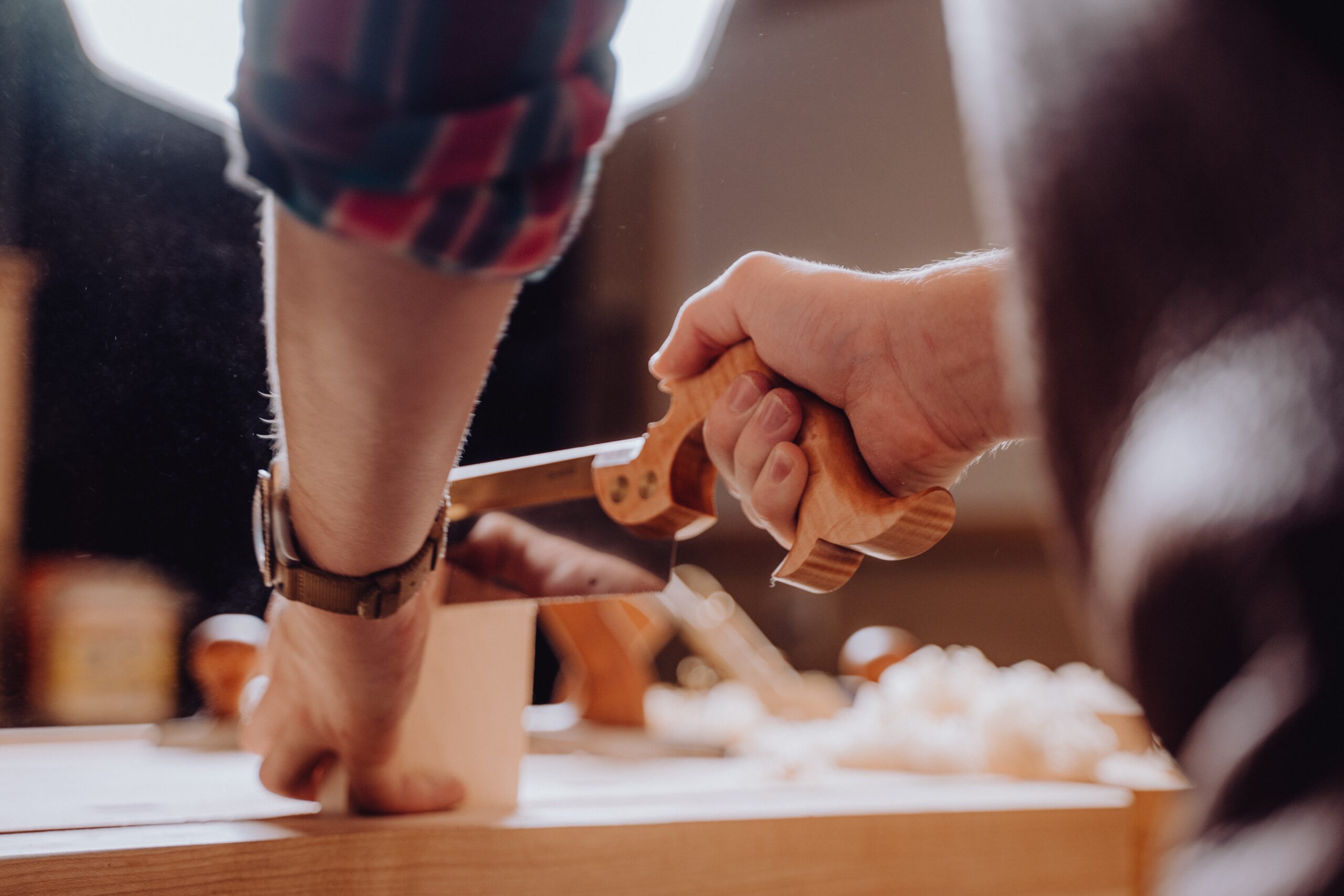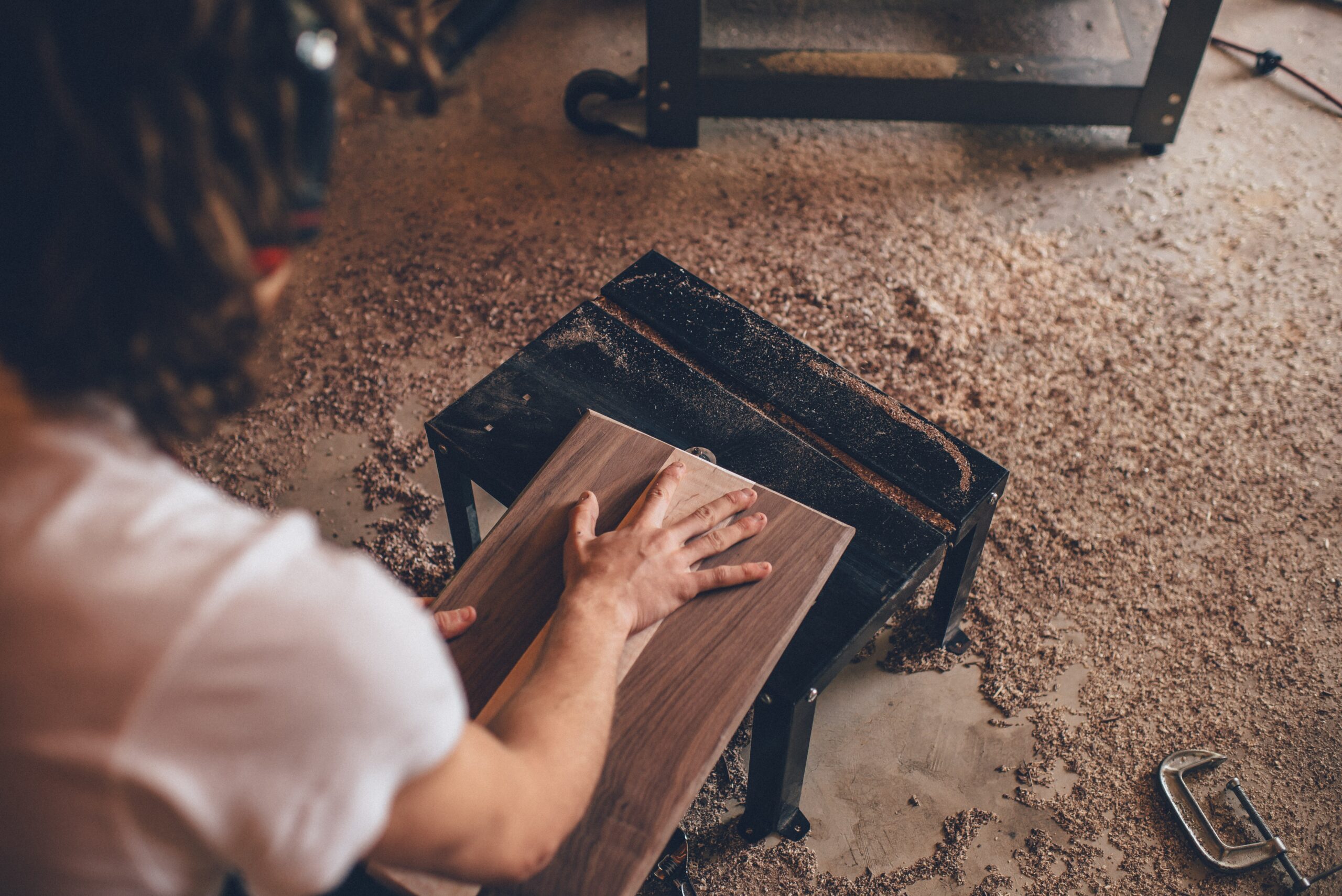One of the most resilient joinery methods, mortise and tenon joints have been around for as long as woodworking itself. They might be simple or complex. Although the tenon can have a variety of forms, the mortise is generally the same in all types of mortise and tenon construction. Some of the most common are these three.
Layout the joint
Layout the joint’s size and position using the combination square. You must first ascertain the thickness of the tenon, since it will dictate the size of the mortise.
A tenon should, in general, be one-third the thickness of the board. When the board is marked for cutting on the top, end, and bottom (this marks the cheeks), double the thickness of the board by three and set the combination square to that measurement.
Use this measurement to indicate the mortise if the board you are mortising has the same thickness. Then, according to the required depth of the mortise, mark the tenon shoulders.
Cut the tenon.
To observe the lines indicating the cheeks, clamp the board in a vice. With the handsaw, cut the cheeks slightly outside of those markings. Always halt at the shoulder markers.
After cutting the cheeks, slide the board back into the vice to cut the shoulders. To adjust the cheeks to size, use the chisels.
Drill the mortise
Install a drill bit in a power drill that is just a little bit smaller than the mortise’s width. Drill multiple holes into the mortise while keeping the drill as level as you can. Drilling outside of the mortise will result in a loose fit for the tenon, so take care to avoid doing so.
Use chisels to fit the mortise precisely
Use the chisels to fine-tune the mortise hole after the drill has removed the majority of the mortise material. To stop the mortise from splitting, first score the edges with a utility knife. Next, gently line the tip of the chisel with the mortise’s edges, and tap the chisel’s butt with a hammer to remove tiny pieces of wood at a time (you may also use hand pressure). Take a break now and then to clean the mortise of shavings.
Test fit the joint
Make regular stops to test fit the joint while you adjust the mortise. Mark any potential tight spots with the pencil to make adjustments with a chisel or sandpaper for a precise fit. If it seems like something is going slowly, that’s because it is. To ensure a snug fit, remove little portions of wood at a time.
Secure the joint
The joint is ready for fastening when it fits snugly. Apply wood glue to the tenon’s cheeks, shoulders, and a little within the mortise as well. When the tenon is entirely seated, slide it into the mortise and give it a little tap. Fix it with a clamp.
Pegs can be used to hold the joint together if you’d rather not use glue. Drill a hole entirely through the mortise after removing the tenon from the joint. Next, insert the tenon into the mortise and use the pencil to indicate the peg positions on the tenon before taking it out once more. The tenon should then be drilled through using a drill bit at the marked locations, but just slightly (1/16 of an inch is sufficient). Reinstall the tenon and use a hammer to pound the pegs into the joint. This process, known as “draw boring,” will bring the joint closer while preserving the ability to dismantle the joint if necessary. All you have to do is tap the peg out again.
Tips for Perfecting Your Wood Joinery Techniques in Mortise and Tenon
Achieving a snug fit
A great level of accuracy is needed to build a good mortise and tenon joint. The tenon must fit snugly into the mortise along the breadth of the timber (requiring manual pressure to push the tenon into the mortise) in order to create a sturdy bond. The tight fit between the matching wood pieces produces friction, which prevents the joint from breaking apart.
This close fit is necessary to enable effective glue adherence to bond the two pieces of wood together if glue is to be applied to the joint. If the tenon width is too small, neither sufficient surface-to-surface contact for a strong glue bond nor friction to resist stress will exist. If the tenon is too wide (it needs to be hammered into the mortise with a mallet), you run the danger of the wood expanding and, if glue is used, starving the joint of glue.
Cutting the mortise first and then the tenon to fit is the proper order to cut when making a mortise and tenon joint. If necessary, it is far simpler to change the tenon’s size than the mortise’s.
A mortise can be classified as “open” or “through” if it cuts through the wood completely, or as “hidden” or “blind” if it cuts through the wood just partially.
A “through” tenon is one that passes completely through the mortise. A “stub” or “blind” tenon, on the other hand, is one that is completely encompassed by the mortise.
Following are some broad guidelines that craftsmen have evolved throughout time for correctly measuring their mortise and tenon joints:
Tenon length: A tenon should be at least five times longer than it is wide. A 1/4′′ thick tenon should thus be 1-1/4′′ long. Of course, if you look at ancient furniture, you’ll notice a number of examples of this “rule” being broken, or perhaps the furniture was created before the rule was created! The idea is that these laws are only suggestions.
Tenon thickness: The thickness of a tenon ought to be one-third that of the stock being mortised. Because of this, the tenon used to link two pieces of 3/4″ material should be ¼” thick, or 1/3 of ¾. The tenon should be 1/2 thick (1/3 of 1-1/2) if you are attaching a 7/8-thick apron to a 1-1/2-thick table leg.
Tenon Width: This tip has two parts. The tenon should first be cut to be half the width of the rail you are cutting it on; for example, a two-wide rail would have a one-wide tenon. Second: You should divide the tenon into two (or more) if its breadth is larger than six times its thickness. Example: On a 6′′ wide rail, you wish to cut a 1/4′′ thick tenon. According to the guideline, your tenon must be 3 inches broad. However, a 3-inch tenon is wider than a 1-1/2-inch tenon, which is six times as thick. That tenon must be split into two 1-1/2″-wide tenons.
Fine-tuning with hand tools
The ability to make tight wood connections, where the edges merge perfectly, making two connected parts appear like a single piece, is the distinguishing feature of competent woodwork. Making accurate cuts to build most sorts of wood joins is needed. Several tools may be used to fine-tune the project:
Ridge-free rabbets
For smoother edges and a stronger glue bond, you may smooth rabbets all the way up to the shoulder with a shoulder plane.
Thin to see through
Joints are quickly, but not always precisely, cut by machines. Sanding blocks, chisels, and planes remove wood in thousandths of an inch for a tight connection; that’s when you bring in hand tools.
Do not immediately go out and get a block plane or shoulder plane if you do not already have one. Start out simply by creating a sanding block from of scraps, sandpaper, and spray glue for pennies. Then include a decent set of bench chisels with bevel edges. As your joinery abilities advance, replace your sanding blocks with well-honed block and shoulder planes to save time.
Sanding blocks: Slow but simple
For cleaner edges and a stronger glue bond, smooth scoring from tablesaw-cut rabbets, dadoes, or stub-tenon grooves. Adjust half-lap depths to make components flat. Reduce tenon thickness by sanding the cheeks. Make the shoulders even with each other as in the photo. To fine-tune coped ends on molding, wrap sandpaper around varying-sized dowels to create a curved sanding block.
Flatten saw blade dadoes
Match the grit to the quantity of stock to be removed; for deep score line removal, start at 80 grit; for small tenon modifications, 120 grit works fine. Next, adjust the block size to the task. To create a sanding block that covers the full dado in a single pass, plane a scrap block to the thickness of your dado widths, as shown in the photo. Pick a hardwood sanding block that will maintain a clean edge, and just sand one surface, not neighboring faces or edges. This enables you to change a joint’s one dimension without changing the others. Small sanding blocks’ abrasives wear quickly, so replace the paper often.
Chisels
Trim smooth walls and square ends on drilled mortises, as shown in the photo. For an edge sharp enough, hone the bevel and flatten the back.
A chisel cuts by going with the grain. If you start to feel the chisel sink into the wood when making paring cuts with the grain, cut in the other direction. If that isn’t a possibility, tap the chisel to produce 1/16″ stop cuts, then cut the wood between the stops while holding the chisel perpendicular to the grain.
More tips on mortise and tenon joints
Here are more tips in making mortise-and-tenon joints that will help you create joints that fit perfectly and are stronger for all of your projects:
- Accurate planning is the foundation for all great mortise-and-tenon joints. To produce the layout markings, use a sturdy steel rule and square together with a sharp pencil, marking gauge, or marking knife.
- As a general guideline, split the mortised workpiece into thirds when setting out a mortise in end or edge grain. The central third will be removed, and the two outside thirds will become the mortise walls. Thus, to create a mortise that is 1⁄4″ wide and centered on the 3⁄4″ edge for a board that is 3⁄4″ thick, as seen below. If the stock is thicker than 3⁄4″, you can widen the mortise beyond one-third the thickness of the stock, as long as the walls of the mortise remain at least 1⁄4″ thick for structural integrity.
- It’s simpler to adjust the size of a tenon than a mortise, so cut your mortises first and then build your tenons to fit.
- Smooth-surfaced joints yield the finest glue bond.
- A proper-sized tenon should dry fit so tightly that it can be inserted or removed with only a little bit of hand pressure while still staying in the mortise when flipped upside down.
- Mortises that are routed or drilled out will have rounded ends. To suit a rectangular tenon, you can use a chisel to square them up. If you want to save time and work, just make rounded tenons to match.
Common Mistakes and How to Avoid Them
When creating a mortise and tenon joint, you should avoid making the following mistakes:
- Cutting the mortise too deep or shallow.
- Too thin or thick cut for the tenon.
- Not taking exact measurements.
- Moving too quickly.
- Mortise-and-tenon joints should not be cut unevenly.
- Apply lots of glue to close the gaps.
- The wood may shear on both sides if the measurements are off.
- Do not completely chisel through.
Troubleshooting Your Wood Joinery Techniques in Mortise and Tenon
When it comes to woodworking, there are always techniques to do tasks more quickly, simply, and effectively. Wood joinery is no exception. When utilizing their equipment or procedures, novice woodworkers frequently make several blunders that generally result in the wastage of materials. Here are a few ways to troubleshoot your wood joinery:
Correcting a loose joint
Reattaching tiny shims to the tenon’s sides using adhesive is an easy fix. If only one side of the tenon is shimmed, the piece may be off-center when refitted. To get the ideal fit, go back to the paring stage once the shims have dried. Take a time to ease the tenon’s harsh edges. This will make assembly a little less stressful and allow some room for excess glue.
Fixing an overly tight joint
It should be a touch too tight if you left any extra flesh on the tenon’s sides, so go back to the bench hook and thin the sides. The ideal partner will be a rabbeting block plane or shoulder plane. If you know how to use and are comfortable with the tools you have, they should function perfectly. Just remember to verify the fit and take little shavings along the way. A well-fitting joint ought to be able to be assembled just by hand pressure. You’re not there yet if you need to use a mallet to seat the joint. Don’t force it home. Remove a little extra trash but take care not to eliminate it beyond what is required. When the parts can be pressed together and held upright at a 45° angle, the joint can be described as well-fitting.
Uneven Mortise-and-Tenon Joints
Because they must fit securely to function effectively, mortise-and-tenon joints must always be cut precisely. Even when using quality tools, cutting things little unevenly is a relatively typical error, especially among novices. The typical idea is to use a lot of glue to fill up the gaps. An improved technique would be to take a thin, little piece of wood, insert it into the opening, secure it with glue, and then clamp it to the tenon’s sides. Keep in mind to align the wood’s grain with the undersized tenon’s grain. After that, you’ll get another chance to sever the tendon.
Used a dull saw
Using a dull saw will need more power, and when you exert more pressure to cut through the material, it’s possible that the blade could move out of position or make a jagged cut, which might destroy your project. This may be avoided by making sure your saw is sharpened before use.
Cut too deep
Removing extra wood by hand should be possible, but it might take time and be annoying if your saw doesn’t stay in the groove. This procedure will go more quickly, smoothly, and precisely if you use a flush trim saw.
Cut too much in one go
Wood is a difficult material to work with. It should be able to fold over with ease, but not so readily that it breaks or cracks. Practice makes perfect, so instead of attempting to cut through a whole board the first few times, consider cutting your material into tiny pieces.
Used the incorrect blade
Different materials (and uses within those materials) require different blades. Plywood is an excellent example; you don’t want to cut it with a small blade designed for thin woods since it might cause the plywood to split.
Cut the wood at the wrong angle
This mistake is also connected to the sharpness of your blade; if you have trouble cutting something straight, examine your blade and angle of attack. It’s likely that you’re applying too much effort or that the blade is at the incorrect angle if the wood isn’t cutting through the material without resistance—that is, if it tries to bend rather than split.
Using a sharp saw and taking your time to let each cut finish slowly before going on to the next can eliminate all of these mistakes. You will have greater control over the parts and how they fit together if you take your time.
To know more on appropriate tools to use in woodworking, click this: https://myhobbylife.com/woodworking-tool-accessories/
Conclusion: Mastering Mortise and Tenon in Wood Joinery Techniques
Summary of the importance of Mortise and Tenon
Strong and reliable, mortise and tenon joints may be employed in a variety of tasks. By either gluing or locking into place, they provide a robust result. The mortise and tenon joint has a nice appearance as well.
Long before woodworkers had access to dependable glues, mortise and tenon joinery was utilized. Rather, they were forced to depend on alternative techniques for securely fastening a tenon into its mortise. Using a wood pin was one of the most typical fixes for a mortise and tenon joint. Even while a mortise and tenon may be easily put together with glue these days, a pinned joint can be just as sturdy and even have a few benefits. Apart from any structural advantages, some projects add visual appeal by pinning the tenons. An otherwise flat, simple surface is made intriguing by the exposed pin ends. Furthermore, they make it clear what kind of joinery is used to keep the assembly together.
The mortise and tenon joint is quite simple. Like any other woodworking method, results may be increased with a little bit of mastery of this age-old wood joinery technique.
Final thoughts
Advanced woodworking joinery techniques need tenacity, dedication, and a desire to put theory into reality. But there’s no denying the unmatched degree of workmanship these approaches bring to your work. It is therefore well worth the time to study and practice these techniques. You may create pieces that exhibit power and grace and will be appreciated by people for many centuries to come if you are willing to do this task.


